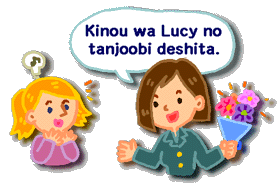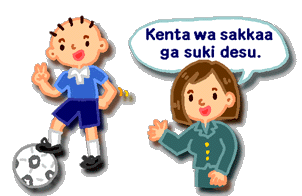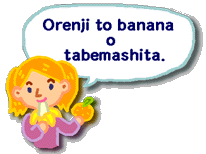Kids Web Japan
Web Japan > Kids Web Japan > Language > Lesson 6 > Grammar
Language
Lesson 6: What Do You Like?
Grammar
Grammar
- Past affirmative (yes) and negative (no) form of
 (to be):
(to be):
Affirmative Negative Non-past 
desu 
dewa arimasen Past 
deshita 

dewa arimasen deshita
As you learned in Lesson 4, Japanese verbs have a non-past form, used for the present and the future, and a past form. You make the negative of the past tense by attaching (deshita) to the negative non-past form.
(deshita) to the negative non-past form.

Kinoo wa Lucy no tanjoobi deshita.Yesterday was Lucy's birthday. 




Purezento wa seetaa deshita.The present was a sweater. 



Shatsu dewa arimasen deshita.It was not a shirt. 
 (suki) like, be fond of
(suki) like, be fond of
 , or "like," is classified as a noun, not an adjective. This means you have to use the particle
, or "like," is classified as a noun, not an adjective. This means you have to use the particle  to mark the thing that is liked.
to mark the thing that is liked.







Kenta wa sakkaa ga suki desu.Kenta likes soccer. 








Lucy wa tenisu to sakkaa ga suki desu.Lucy likes tennis and soccer. 






Kenta wa tenisu ga suki dewa arimasen.Kenta does not like tennis. 
 (to): and
(to): and
 is used like the word "and" in English. When you combine many things in English, you say "A, B, C, D and E," but in Japanese you use
is used like the word "and" in English. When you combine many things in English, you say "A, B, C, D and E," but in Japanese you use  every time: "A to B to C to D to E."
every time: "A to B to C to D to E."






Orenji to banana o tabemashita.( I ) ate an orange and a banana. 







Orenji to banana to kukkii o tabemashita.( I ) ate an orange, a banana and cookies. 






 (kore, sore, are, dore): this and that...
(kore, sore, are, dore): this and that...

(kore) indicates a thing or things close to the speaker. 
(sore) indicates a thing or things close to the person the speaker is talking to. 
(are) indicates a thing or things "over there," or distant from both the speaker and the person being talked to. 
(dore) is a question word that means "which one?" It is used when choosing one of several things.
